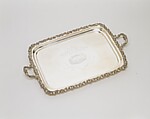Tray
Stephen Richard American
This commanding tray was presented by the Corporation of the City of New York to Charles Rhind (1779-1857) in thanks for and recognition of his work on two momentous civic occasions, the 1824 reception held for the Marquis de Lafayette and the 1825 celebration marking the opening of the Erie Canal. Rhind, a Scottish-born merchant whose successful career included engaging in trade with the Ottoman port of Smyrna and acting as agent for the North River Steam Boat Company, chaired the reception committee that welcomed Lafayette upon his arrival in New York and served as admiral of the fleet during the Grand Aquatic Display at the Grand Canal Celebration. The tray’s meticulously engraved scene of New York harbor bearing the signature of J. D. Stout underscores Rhind’s service and importance to New York City and is one of few known examples of signed engraving on American silver. Presented to Rhind in 1826 together with a similarly decorated cake basket also marked by Stephen Richard and a four-piece tea set marked by another New York silversmith, Garret Eoff (1779-1845), this tray exemplifies the complex relationships that existed among New York silversmiths during the early nineteenth century. The die-stamped border framing this tray appears on silver marked by other New York shops, and Richard may have subcontracted silversmithing to other local silversmiths including Garret Eoff, who by 1825 had discontinued retailing his work and instead devoted himself solely to manufacturing silver. That the tray was accompanied by silver marked by Eoff suggests it may have been produced by Eoff and retailed by Richard. The sharing of die-stamped borders and subcontracting parts or all of commissions are practices characteristic of the dynamic and interconnected silversmithing trade that flourished in nineteenth-century New York City.
Due to rights restrictions, this image cannot be enlarged, viewed at full screen, or downloaded.

